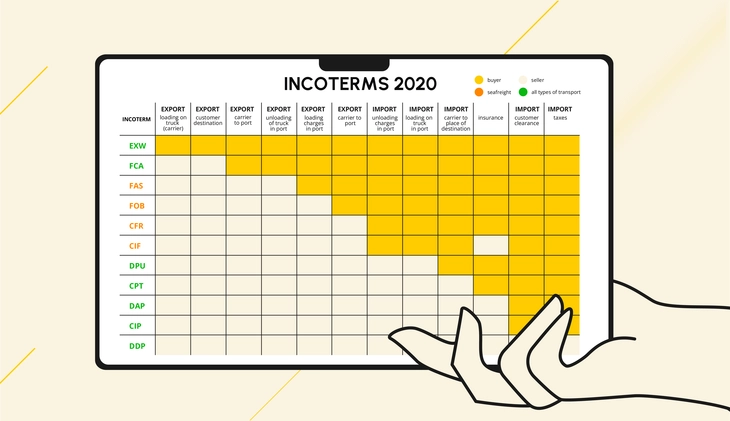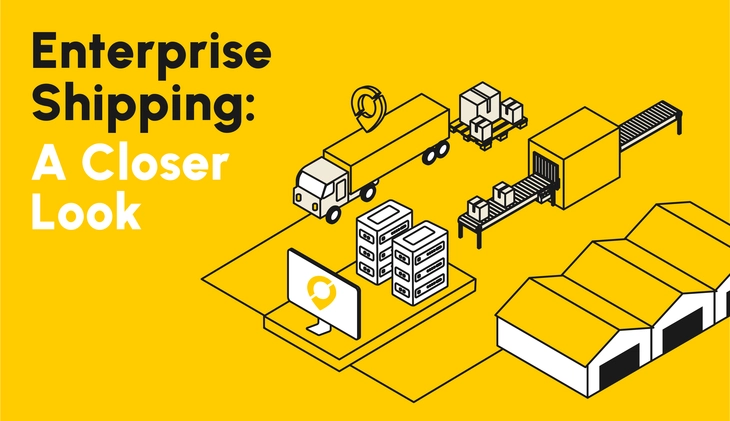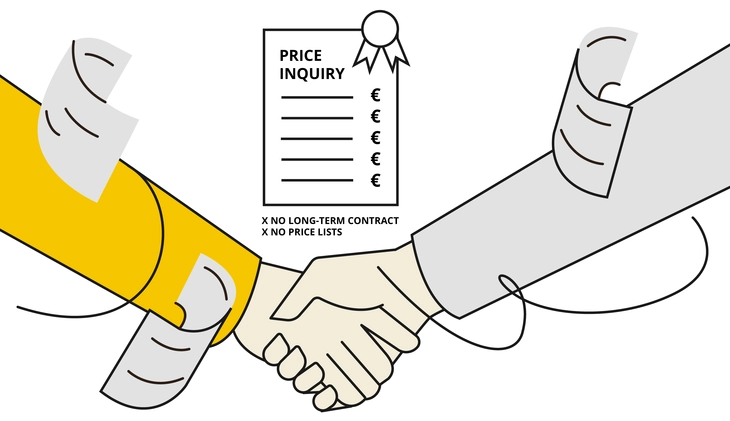Transport tenders or freight procurement may seem complex and daunting to undertake, but it organizing them might actually be simpler than you thought.
In its broadest sense, what do we mean by "transport tender"? Definition: A tender where a company decides to use multiple transport service providers for its freight needs. For many companies in Europe, the common tender period is one year.
Definitions
Before going through the guide to conducting a transport tender in the next chapter, let's define some more key terms related to the process.
-
Transport Tender, also known as Freight Procurement: These terms refer to the process where a company invites multiple transport service providers to bid for providing freight services. It's a systematic and fair method of selecting a service provider based on cost, service, lead times, reliability, availability, and other factors that are important to the company. Tenders typically cover a specific period, often one year in many European companies. Freight procurement is a standard process in enterprise shipping, but is also getting more common common among small businesses using a TMS.
-
Shipment Tender / Load Tender: This is where a shipper conducts a tender for a single load, or a one-time transportation need. For further reading, check out our previous article "What is Spot Freight?". In that blog post, you learn how spot freight can provide solutions for unexpected shipping needs, potential cost-saving opportunities, and the uncertainties and risks it comes with. However, the focus of the current article is the long-term contract procurement process, which is transport tendering or freight procurement.
-
Freight Tender Software: These are digital tools designed to automate the process of freight tendering. Freight tender tools help in creating tender documents, managing bids from various carriers, comparing them based on multiple parameters, and eventually selecting the most suitable one(s). The software typically includes features for document management, communication with bidders, bid analysis, and reporting.
In this blog post, we will provide you with practical tips, tools, and templates for organizing a simple transport tender. Our main focus here is on freight procurement or transport tendering as a long-term contract process, rather than addressing single load or shipment tenders.
The key principles to follow when organizing a freight tender:
- Be open;
- Prepare simple and clear documentation;
- Keep your word and make firm decisions.
5 Steps to Conduct a Successful Transport Tender
1. Understand your business, the goods you ship and your operational routes (freight statistics).
Answer the questions transport companies will ask you. These are crucial as they'll influence the terms of your freight (delivery time, type of service, freight cost, payment deadline, credit limit, etc).
So, anticipate these questions and be prepared to answer:
- What's your company's field of business? How important is transport in your business? What's your annual transport cost?
- What are your goods? Are they parcel, LTL or FTL goods? Standard goods, or dangerous goods? Are they temperature-sensitive?
- How are these goods packaged? E.g., loose, shrink-wrapped on pallets, rolls, big bag, tanker, etc.
- How can these goods be loaded? E.g., stackable or not, tail lift loading/unloading (no access with a large semi-trailer), fragile goods, strapping required, etc.
Carriers will be particularly interested in your previous period's freight statistics. This allows them to evaluate and assess their fit in their transport chain - goods, delivery locations, volumes, transport routes, etc.
Where do your goods move? What are the quantities involved? What's the regularity of your transports? Do your transports have seasonal fluctuations?
Cargoson can help!
With Cargoson's freight management software, your company's freight statistics are displayed on your account in interactive graphs and tables, as well as in downloadable Excel format. This allows you to process and share your freight statistics with your freight partners along with other tender documents.
2. Select the right carriers to send the tender to.
You will only achieve the best results if you send your tender to the right transport companies. Therefore, it is essential to analyze your current list of carriers and think about who else might be suitable for the new tender.
The carriers, their employees, and their delivery networks are constantly changing. It is not an exception at all if a carrier who has not previously offered the best conditions is clearly the best in the next tender, and your current freight partner needs a "wake-up call". To ensure active participation and interest of the providers, it is important to know the market and know whom to invite to the tender.
If you need a carrier selection script to follow when discussing with potential carriers, we go over the main principles in this article: Selecting a Freight Carrier: 10 Tips [+ free scorecard]. There's also a downloadable scorecard you can print out and use as your guide.
Cargoson can help!
Our software features more than 1000 carriers and we have the experience to know who is actively operating in different freight modes, directions, and goods groups. Cargoson, as a freight management software provider, stands with the customer in a neutral consultant role, thereby providing independent industry expertise and recommendations.
3. Establish your carrier allocation strategy before conducting the transport tender.
Here, you should think through and determine the strategy for allocating carriers and freight lines.
An important aspect of designing a carrier allocation strategy is certainly the ability to serve major transport routes and/or customers with special requirements.
Also, don't forget to talk with your company's strategic or large customers to understand their readiness for a possible change of transport partner.
Most often, though, your carrier selection and route allocation strategy will be determined by the number of carriers your company can realistically manage daily. A multi-carrier shipping software can help you manage many more carriers (while boosting transparency) without increasing personnel, by having them all on one dashboard and a standardized workflow.
Possible allocation strategies:
- One carrier per country
- One carrier per region/postcode
- One carrier per origin or destination (supplier or customer)
- One carrier based on goods volume
- One carrier based on goods group
- Combinations
Cargoson can help!
Cargoson's software is designed to help the sender find the best transport conditions for them, regardless of how many freight partners are needed. Whether your carrier allocation strategy results in 2 or 12 freight partners no longer matters — ordering, tracking, and managing transport from Cargoson's transportation management software is just as easy!
4. Create a simple and clearly understandable tender document (shipping conditions and price list template).
A typical tender document (RFP - Request for Proposal) explains what is expected from the carriers and describes your transport needs, such as shipment profile, nature of goods, regularity of shipments, and details on what should be included in the price (e.g., fuel surcharge, insurance, tolls). Although the level of detail is up to your discretion, we recommend that your tender document provides enough details so that carriers know the basis for their price and delivery time offers. Read more on how freight prices are determined from our blog: Freight price explained.
The tender document should be structured, unambiguous, easy to fill out, and easy to compare. The result will be accurate, up-to-date tariffs and delivery times, and a smooth process in your future partnership with your carriers.
Cargoson can help!
Free, downloadable freight procurement document template
Below this article, you can download a best practice example of a simple and clear tender document, which consists of standard freight conditions and a price list template.
Download Cargoson's tender documents, modify your freight conditions, add your origins and destinations to the price list template, and send the transport tender to your freight partner. If the simple freight conditions are not enough, in addition to the price list template, you can also get a more detailed draft of freight conditions.
If you don't know which carriers to send the transport tender to, Cargoson, as a neutral consultant, can help you. Ask for free advice
5. Record and realize your tender results (Cargoson's freight management software).
Once the transport tender has been conducted, further freight contract negotiation is done (if needed), and nominations have been distributed to the carriers, it is necessary to implement the tender results in your ongoing partnership with your chosen carriers.
A simple truth - be clear in your choices and stick to promised nominations. To successfully implement the tender results with your various chosen freight partners, Cargoson's freight management software can help you.
Cargoson can help!
Cargoson's freight rate management software allows you to upload all the price lists received from different carriers to your company's account. The software's advanced price calculation engine gives both you and other people in your company dealing with transport a clear overview of the freight conditions offered by different freight partners. This creates an unprecedentedly simple way to compare and make informed decisions for ordering transport and making decisions. And, to top it off, you don't need to start using a new carrier website or build a carrier API integration yourself, since this is already handled by Cargoson's built-in carrier integration software.
Try Cargoson and see for yourself: Register Account
![How to Conduct a Simple Transport Tender? [+ free template] How to Conduct a Simple Transport Tender? [+ free template]](/rails/active_storage/representations/redirect/eyJfcmFpbHMiOnsibWVzc2FnZSI6IkJBaHBBeENsREE9PSIsImV4cCI6bnVsbCwicHVyIjoiYmxvYl9pZCJ9fQ==--0770c20699a76b88a052bbfa35e1ab55beb6d4d8/eyJfcmFpbHMiOnsibWVzc2FnZSI6IkJBaDdDRG9MWm05eWJXRjBPZ2wzWldKd09oSnlaWE5wZW1WZmRHOWZabWwwV3dkcEFwd0VhUUtvQWpvTVkyOXVkbVZ5ZERzRyIsImV4cCI6bnVsbCwicHVyIjoidmFyaWF0aW9uIn19--10281eab5d8180fcaa878b0a83890b25b0279440/how-to-conduct-a-simple-transport-tender-freight-procurement-cargoson.jpg?locale=en)


![Ultimate Logistics Management Comparison Chart [FREE DOWNLOAD] Ultimate Logistics Management Comparison Chart [FREE DOWNLOAD]](https://www.cargoson.com/rails/active_storage/representations/redirect/eyJfcmFpbHMiOnsibWVzc2FnZSI6IkJBaHBBekhJS1E9PSIsImV4cCI6bnVsbCwicHVyIjoiYmxvYl9pZCJ9fQ==--d972bea48fd4ca35d6c910b43830a3ba66048084/eyJfcmFpbHMiOnsibWVzc2FnZSI6IkJBaDdDRG9MWm05eWJXRjBPZ2wzWldKd09oSnlaWE5wZW1WZmRHOWZabWwwV3dkcEF0b0NhUUwwQVRvTVkyOXVkbVZ5ZERzRyIsImV4cCI6bnVsbCwicHVyIjoidmFyaWF0aW9uIn19--2c7d6c6b28c4d68db8f7c1f368d1bcdc6ab5275a/Ultimate%20Logistics%20Management%20Comparison%20Chart.jpg?locale=en)


